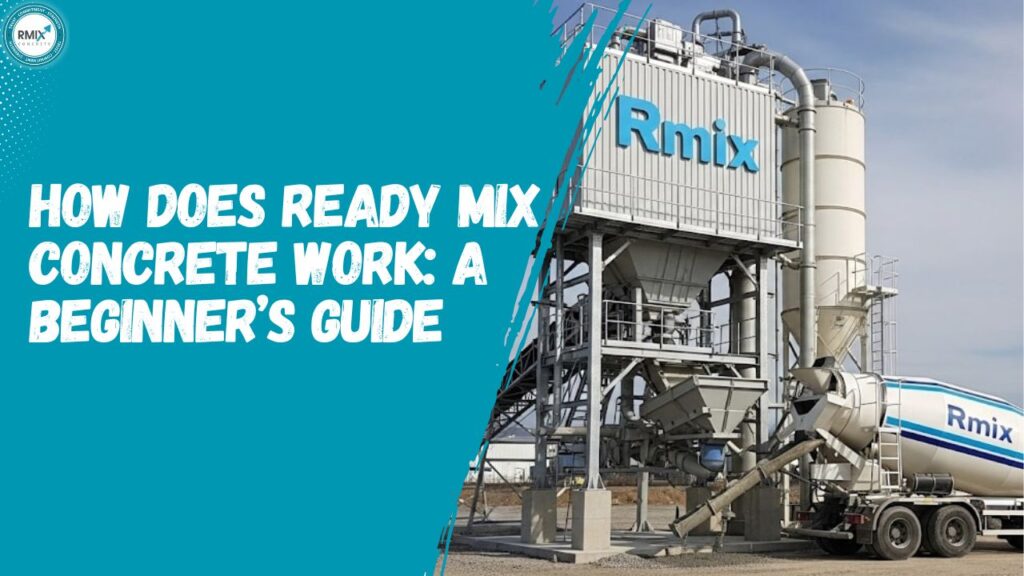
How Does Ready Mix Concrete Work: A Beginner’s Guide | Rmix
The Ready-Mix Concrete Process: A Complete Guide
When it comes to modern construction, Ready Mix Concrete (RMC) has become the backbone of every big and small project. Whether it’s building a home, a commercial complex, or a large infrastructure project, RMC ensures quality, speed, and cost-effectiveness. But if you are new to construction, you may wonder – how does ready mix concrete actually work?
In this beginner’s guide, we’ll break it down step by step. You’ll learn what RMC is, how it’s made, how it is delivered, and why it is a smarter choice compared to traditional site-mixed concrete.
What Is Ready Mix Concrete?
Ready Mix Concrete is a specially designed mixture of cement, water, sand, and aggregates that is prepared in a batching plant under controlled conditions. Unlike site-mixed concrete, which is made manually at the construction site, RMC is manufactured using advanced equipment and strict quality checks.
Once prepared, the fresh concrete is loaded into transit mixers (concrete trucks) and delivered to the construction site. This ensures the mixture is consistent, durable, and ready for use.
How Does Ready Mix Concrete Work?
The working of RMC can be understood in three main stages:
1. Manufacturing Process at the Plant
- Raw Materials Selection: High-quality cement, sand, aggregates, and water are carefully selected.
- Batching & Mixing: Ingredients are measured in precise proportions with the help of computerized batching machines.
- Quality Testing: Each batch goes through strict tests to ensure strength, workability, and durability.
- Loading in Transit Mixers: The fresh concrete is filled into rotating drums of transit mixers, which keep it in motion to avoid hardening.
2. Transportation to Site
- The concrete is transported in special mixer trucks.
- During transportation, the drum of the truck rotates continuously to maintain the uniformity of the mix.
- RMC plants usually deliver within 90 minutes of batching, so the concrete remains fresh.
3. Placement at the Site
- On arrival, the concrete is discharged directly into the required area using pumps or chutes.
- Workers spread and compact it properly to remove air gaps.
- Finally, curing is done to allow the concrete to gain strength over time.
Types of Ready Mix Concrete
Different projects require different strengths and workability. That’s why RMC is available in various types:
- Transit Mixed Concrete – Most common; mixed during transit in the truck.
- Shrink Mixed Concrete – Partially mixed at the plant and finished mixing in transit.
- Central Mixed Concrete – Fully mixed at the plant before loading into the truck.
Benefits of Ready Mix Concrete
Here’s why RMC has become the most popular choice:
- Consistent Quality – Computerized batching ensures accuracy in every mix.
- Time-Saving – No need for manual mixing at the site; large quantities can be delivered quickly.
- Cost-Effective – Reduces material wastage, labor cost, and project delays.
- Durability – High strength and long-lasting performance.
- Environment Friendly – Minimizes dust, noise, and pollution at the site.
- Versatility – Suitable for residential, commercial, and large-scale projects.
Applications of Ready Mix Concrete
RMC is used in almost every type of construction project. Some common applications include:
- Residential Buildings – Homes, apartments, and villas.
- Commercial Projects – Offices, shopping malls, hotels, and hospitals.
- Infrastructure – Roads, bridges, flyovers, metro projects, and airports.
- Industrial Construction – Factories, warehouses, and heavy machine foundations.
Why Choose Ready Mix Concrete Over Site-Mixed Concrete?
| Feature | Site-Mixed Concrete | Ready Mix Concrete |
|---|---|---|
| Quality | Inconsistent | Highly controlled |
| Time | Slow and labor-intensive | Quick and efficient |
| Cost | Higher due to wastage & labor | More economical in bulk |
| Strength | Depends on workers | Reliable and tested |
| Environment | Creates dust & noise | Eco-friendly |
It’s clear that RMC offers more advantages in terms of quality, speed, and overall efficiency.
Tips for Beginners When Using Ready Mix Concrete
If you’re planning to use RMC for the first time, keep these points in mind:
- Choose a Reliable Supplier – Always buy from a trusted Ready Mix Concrete supplier in your city to ensure quality.
- Plan in Advance – Inform the supplier about the required quantity and delivery time.
- Check Site Readiness – Make sure the site is ready for pouring before the truck arrives.
- Use Quickly – RMC should be placed and compacted within 90 minutes of delivery.
- Proper Curing – Ensure correct curing for at least 7–14 days for maximum strength.
Future of Ready Mix Concrete
With the growing demand for sustainable construction, RMC is evolving with advanced technologies like:
- Green Concrete – Made with eco-friendly materials.
- High-Performance Concrete – Provides extra durability and strength.
- Self-Compacting Concrete – Flows easily without vibration.
These innovations are making construction faster, stronger, and more sustainable.
Conclusion
Now that you know how ready mix concrete works, it’s easy to understand why it has become the backbone of modern construction. From manufacturing at the plant to delivery at the site, every step ensures quality, strength, and efficiency.
For beginners, the key is to choose the right supplier, plan ahead, and ensure proper curing. With these steps, you can make the most of this innovative building material.
So, if you are starting a new project, remember that Ready Mix Concrete is not just convenient, it’s the smart choice for the future of construction.
FAQs
Q1. What is Ready Mix Concrete (RMC)?
Ans. Ready Mix Concrete (RMC) is a mixture of cement, sand, aggregates, and water, manufactured in a batching plant under strict quality control and delivered to construction sites in transit mixer trucks.
Q2. How Does Ready Mix Concrete Work?
Ans. Ready mix concrete is prepared at the plant, transported in mixer trucks, and delivered fresh to the site. It is then poured, compacted, and cured to achieve the required strength and durability.
Q3. What Are the Advantages of Ready Mix Concrete over Site-mixed Concrete?
Ans. RMC offers consistent quality, faster delivery, reduced labor, cost-effectiveness, and eco-friendliness compared to site-mixed concrete, which often varies in strength and quality.
Q4. How Long Does Ready Mix Concrete Remain Usable After Mixing?
Ans. Generally, ready mix concrete should be used within 90 minutes of batching to maintain workability and strength.
Q5. What Are the Main Applications of Ready Mix Concrete?
Ans. Ready mix concrete is widely used in residential buildings, commercial complexes, roads, bridges, flyovers, metro projects, factories, and industrial construction.
Q6. How Do I Choose the Best Ready Mix Concrete Supplier?
Ans. Look for suppliers with proper certifications, modern batching plants, quality control measures, timely delivery, and good reviews. A trusted local Ready Mix Concrete Supplier in Surat, like Rmix, ensures quality and reliability for every project. Choosing a reputed supplier in your city is always the best choice for convenience and long-term durability.
Q7. Is Ready Mix Concrete Cost-effective?
Ans. Yes, RMC reduces material wastage, labor costs, and project delays, making it more cost-effective in the long run compared to site-mixed concrete.
Q8. Does Ready Mix Concrete Require Special Curing?
Ans. Like traditional concrete, RMC also requires proper curing for at least 7–14 days to gain maximum strength and durability.












